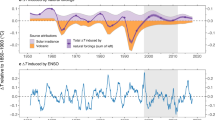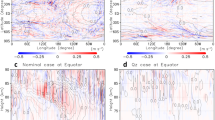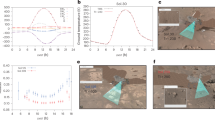Abstract
G. V. GROVES, in a recent communication1, offered an explanation of the marked change in slope of the periodic time curves of the satellites 1958 β, 1958 δ 1 and δ 2. His suggestion of a relatively sharp discontinuity in atmospheric density on passing from the dark to the light side of the Earth is, however, at variance with the work of Kelvin, Rayleigh and Margules on the ultimate effect of solar heating. From their investigations one would expect, as suggested by Kelvin, that the atmospheric distortion produced on the irradiated side of the Earth would lead to a range of Fourier components, that one being most easily detected which corresponded most closely with a natural frequency of tidal waves in the atmosphere. The marked semi-diurnal oscillation in barometric height is ascribed to this effect, and Margules2 has shown that this corresponds to the natural frequency of waves in a rotating isothermal shell of temperature 298° K.
This is a preview of subscription content, access via your institution
Access options
Subscribe to this journal
Receive 51 print issues and online access
$199.00 per year
only $3.90 per issue
Buy this article
- Purchase on SpringerLink
- Instant access to full article PDF
Prices may be subject to local taxes which are calculated during checkout
Similar content being viewed by others
References
Groves, G. V., Nature, 182, 1533 (1958).
Margules, M., Smithsonian Misc. Collections, 843, 296 (1893).
Newell, H. E., Ann. Geophys., 11, 115 (1955).
King-Hele, D. G., and Leslie, D. C. M., Nature, 182, 788 (1958).
Author information
Authors and Affiliations
Rights and permissions
About this article
Cite this article
PARKYN, D. Atmospheric Tides and Earth Satellite Observations. Nature 183, 1045–1047 (1959). https://doi.org/10.1038/1831045a0
Issue date:
DOI: https://doi.org/10.1038/1831045a0
This article is cited by
-
Analysis of Satellite Data
Nature (1961)
-
Tides in the F 2 Ionospheric Layer
Nature (1959)



